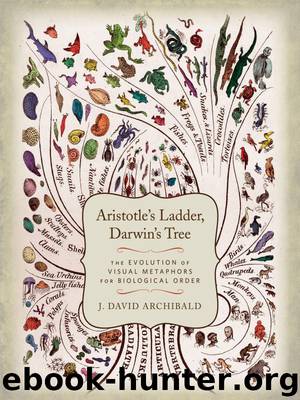Aristotle's Ladder, Darwin's Tree by Archibald J. David

Author:Archibald, J. David. [Archibald, J. David.]
Language: eng
Format: mobi
Tags: SCI027000, Science/Life Sciences/Evolution, SCI088000, Science/Life Sciences/Biological Diversity
Publisher: Columbia University Press
Published: 2014-08-19T07:00:00+00:00
FIGURE 5.6 One of Haeckel’s (A) broom-like tuft diagrams, addressing the issue of the poly- versus monophyletic origin of life, depicted in a slightly different form from his figure in Generelle Morphologie der Organismen (see figure 5.3), and (B) single severe, rectilinear tree of animal evolution, placed in a geologic time scale, from Natürliche Schöpfungsgeschichte (1868).
Haeckel must be given credit for another innovation in his use of tree-like figures that first appeared in Natürliche Schöpfungsgeschichte, but not until the second edition, published in 1870. Scientists such as Alexander von Humboldt (1817) had produced altitudinal zonations of vegetation; others such as Théodore Lacordaire (1839–1840) had drawn up tables indicating the global distributions of various insects (Browne 1983); and still others such as Alfred Russel Wallace (1876) deserve credit for helping to establish the science of biogeography, which deals with the geographic distribution of plants and animals. In the second edition of Natürliche Schöpfungsgeschichte, Haeckel published what appears to be the first map on which is superimposed a tree-like form, albeit a very complex form, that spreads over its surface and shows the origin and radiation of a group—in this case, of humans (figure 5.7). Although Haeckel had no knowledge of genetics, clearly his contribution is an antecedent of today’s study of phylogeography, which concerns the biogeographic spread and distribution of populations, mostly using genetic data. He places the origin of humans on a hypothetical continent in the Indian Ocean. Named Lemuria (presumably after lemur, Latin for “ghost of the departed”) in 1864 by the English zoologist Philip Sclater, it supposedly connected various regions in the Indian Ocean, including Madagascar, home to real lemurs. Haeckel explains in the text that Lemuria subsequently disappeared below the waves. Although quite fanciful sounding to us, the idea of lost continents as stepping-stones for the spread of plants and animals was not an uncommon notion until the theory of continental drift took hold after the middle of the twentieth century, rendering the need for such imagined lost continents generally unnecessary.
Download
This site does not store any files on its server. We only index and link to content provided by other sites. Please contact the content providers to delete copyright contents if any and email us, we'll remove relevant links or contents immediately.
Sapiens: A Brief History of Humankind by Yuval Noah Harari(14322)
The Tidewater Tales by John Barth(12627)
Mastermind: How to Think Like Sherlock Holmes by Maria Konnikova(7281)
Do No Harm Stories of Life, Death and Brain Surgery by Henry Marsh(6908)
The Thirst by Nesbo Jo(6882)
Why We Sleep: Unlocking the Power of Sleep and Dreams by Matthew Walker(6659)
Life 3.0: Being Human in the Age of Artificial Intelligence by Tegmark Max(5520)
Sapiens by Yuval Noah Harari(5325)
The Longevity Diet by Valter Longo(5044)
The Body: A Guide for Occupants by Bill Bryson(5033)
The Rules Do Not Apply by Ariel Levy(4912)
The Immortal Life of Henrietta Lacks by Rebecca Skloot(4552)
Animal Frequency by Melissa Alvarez(4430)
Why We Sleep by Matthew Walker(4395)
The Hacking of the American Mind by Robert H. Lustig(4342)
Yoga Anatomy by Kaminoff Leslie(4335)
All Creatures Great and Small by James Herriot(4277)
Double Down (Diary of a Wimpy Kid Book 11) by Jeff Kinney(4244)
Embedded Programming with Modern C++ Cookbook by Igor Viarheichyk(4144)
